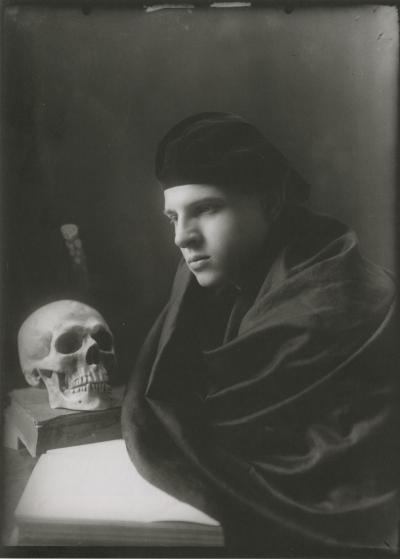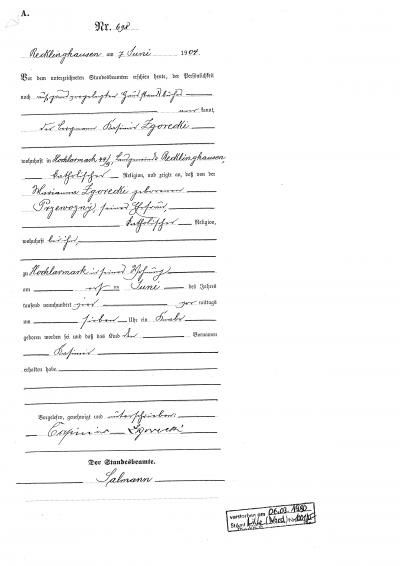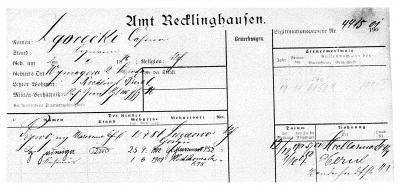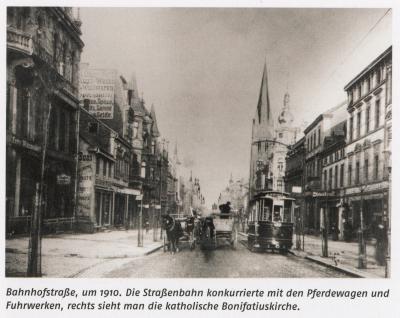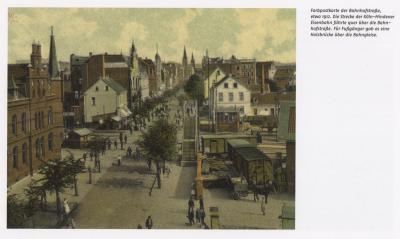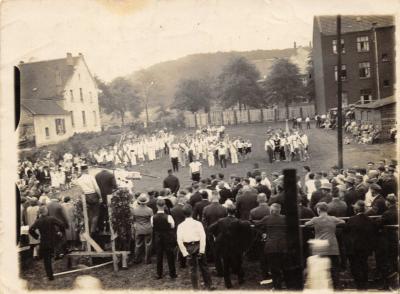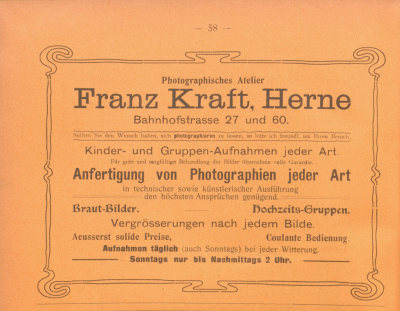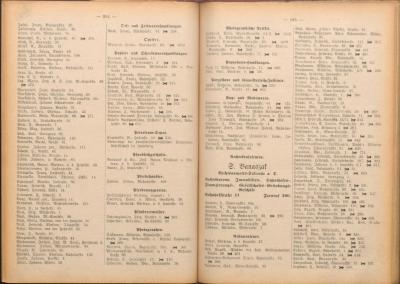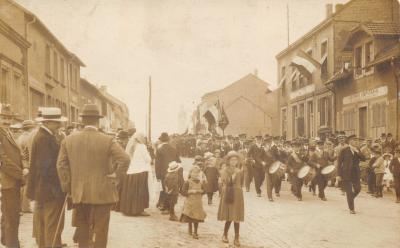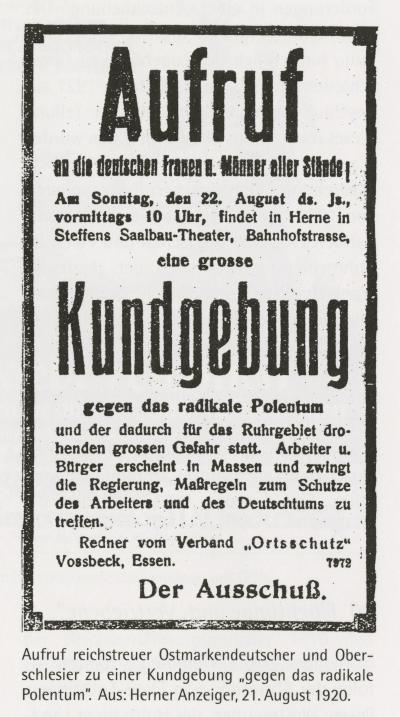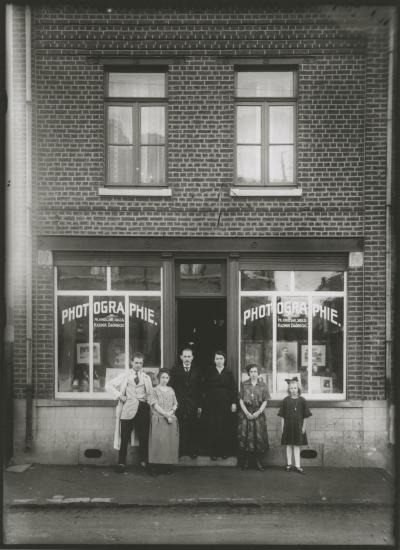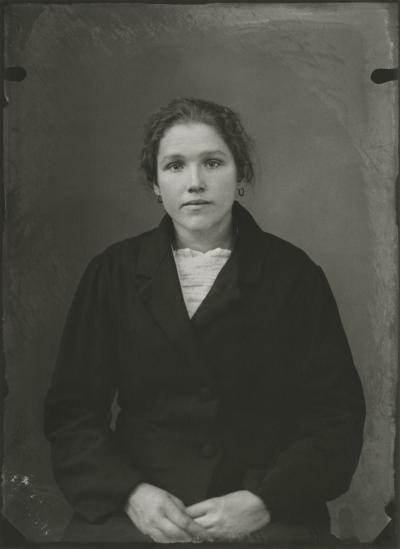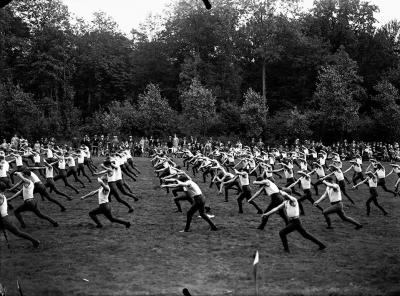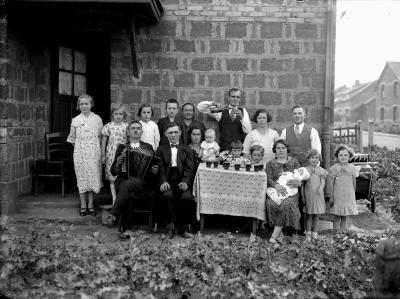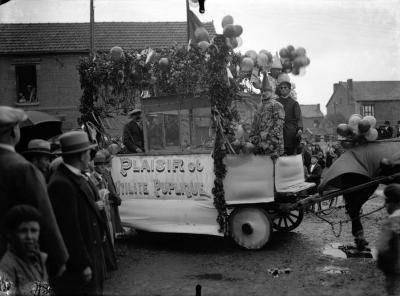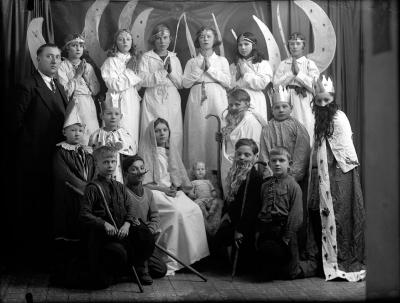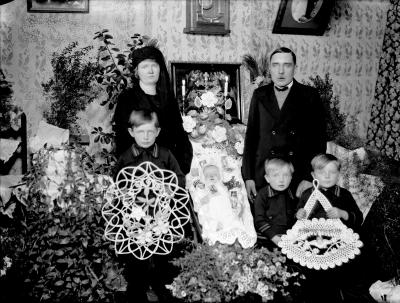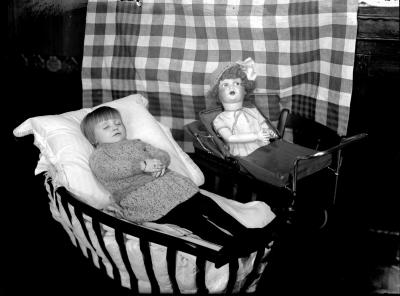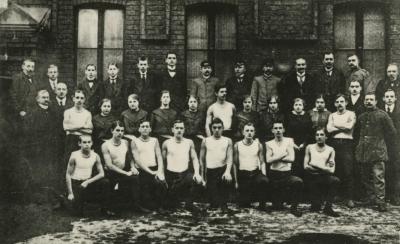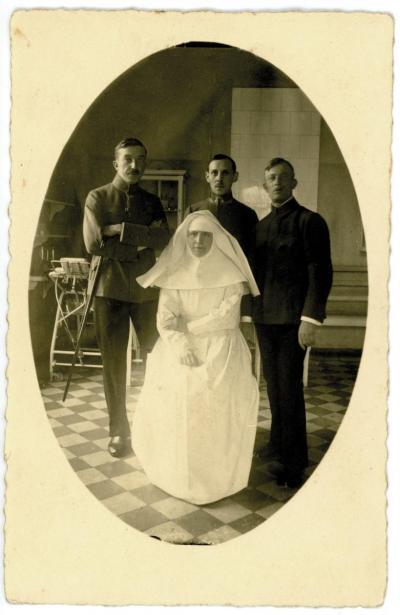Kasimir Zgorecki (1904-1980) – from Recklinghausen to the pantheon of French photography
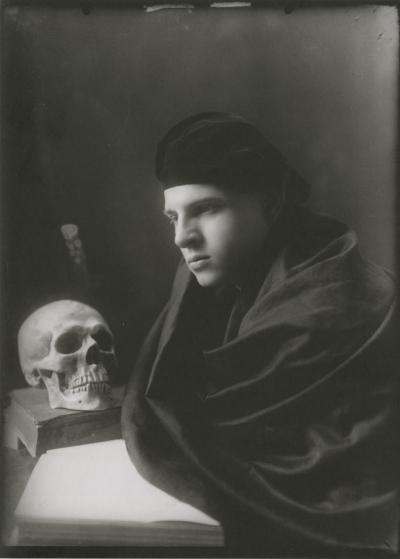
In 1980, Kasimir Zgorecki died in northern France, after working for many years as a successful photographer there. He passed on his passion for photography to both his sons Jacques and Alfred. They too managed their own photography studios, with Jacques taking over his father’s studio in Rouvroy, which had been producing photos for many decades.[1] The historical value of Zgorecki’s longstanding passion was only properly understood after his death in the 1990s, when his granddaughter’s husband Frédéric Lefever discovered 4,000 negatives in the family’s estate consisting of old glass plates which had been kept in the attic of the apartment over the studio.[2] His entire collection must actually have been a lot bigger considering that the crater of a bomb blast in the studio’s garden during the Second World War was covered with negatives.[3] More negatives were confiscated by the police after the blast, which also destroyed part of the photo lab.[4]
The photographs that Lefever rediscovered were taken between 1924 and 1939 and as historical documents, have kept a piece of Polish tradition alive outside the free Polish state. In the post-war years as well, many Polish citizens went on to seek better living conditions abroad and did not consider the repatriation option. That is why Zgorecki’s motifs show the everyday lives of Polish emigrants in a French mining region who, at the beginning of the 20th century, managed to keep their culture alive.
Kasimir Zgorecki’s family originally hailed from the region around Poznań, where his father was born in 1876.[5] At the time, this region was part of Prussian territory, and any job opportunities there were mainly in agriculture.[6] The population growth that had persisted since the middle of the 19th century and the expansion of large land holdings produced, in Poznań particularly, a multitude of impoverished agricultural workers who were employed as seasonal workers or day labourers.[7] The living conditions resulted in an exodus from rural areas; the workers, some of whom were unskilled, moved into towns located in mining regions. This resulted in a considerable decline in population in and around Poznań.[8] These migratory movements were taking place around the time that Zgorecki’s father was settling in the Ruhr area after embarking on the so-called internal migration in Prussia, presumably to make a fresh start as an unskilled labourer.
[1] Frédéric Lefever: Kasimir Zgorecki, p. 11.
[2] Frédéric Lefever: Kasimir Zgorecki, p. 5.
[3] Frédéric Lefever: Kasimir Zgorecki, p. 7.
[4] see: https://fr-fr.facebook.com/pg/KasimirZgorecki/about/?ref=page_internal (last accessed on 2 July 20)
[5] Frédéric Lefever: Kasimir Zgorecki, p. 7.
The Zgorecki family in Recklinghausen-Hochlarmark
In 1870, Recklinghausen was connected to the already quite extensive rail network and this made the journey from the eastern provinces much easier.[9] As a result, the population of Recklinghausen had almost doubled by 1885 when the town had 75,000 inhabitants. By 1905 there were around 300,000 inhabitants.[10] It is assumed that the first “Ruhr Poles” did not establish themselves in Recklinghausen until after the depression in the 1880s and 1890s because, to this point, the sinking of the mines had not required much labour and any labour that was needed was recruited from the surrounding areas.[11]
Kasimir Zgorecki’s birth certificate reveals that he was born in Hochlarmark on 1 June 1904 (see Fig. 2). Both of his parents are also entered on the certificate and his Catholic denomination is noted. The certificate can still be viewed today in the Recklinghausen City Archives. Around this time, the district’s image was undergoing continuous change and was developing in line with the migration so that it could offer the many miners and their families accommodation in the direct vicinity of their workplaces. Whilst the Zgorecki family continued to live in Recklinghausen-Hochlarmark for another three years after Kasimir’s birth, construction of the well known ‘triangle housing estate’ began in 1901 and was finished in 1907. It was constructed to house the large number of miners at the Clerget II mine (later named Recklinghausen II)[12] and got its name from the geometric arrangement of the streets. Around the turn of the century, the triangle housing estate also had cheap accommodation in which livestock could also be kept.[13] Built by Harper AG, this housing estate was made up of 130 houses and 400 apartments and was considered a state-of-the-art showcase for migrant life.[14] Everyday life in the colonies, however, also meant that the Ruhr Poles kept themselves to themselves and were somewhat isolated from the locals.
[9] Matthias Kordes: Wohnen, Leben und Arbeiten von Fremden im Revier, p. 285.
[10] Matthias Kordes: Wohnen, Leben und Arbeiten von Fremden im Revier, p. 286.
[11] Werner Burghardt: Die polnischen Arbeiter sind…fleißig und haben einen ausgeprägten Erwerbssinn, p. 403f.
[12] cf. Werner Burghardt: Die polnischen Arbeiter sind…fleißig und haben einen ausgeprägten Erwerbssinn, p. 405.
[13] Werner Burghardt: Die polnischen Arbeiter sind…fleißig und haben einen ausgeprägten Erwerbssinn, p. 405.
[14] Matthias Kordes: Wohnen, Leben und Arbeiten von Fremden im Revier, p. 286.
As well as the housing estate, the Catholic church of St. Michael was also built in 1900, shortly before Kasimir’s birth.[15] It is also unlikely that the choice of patron saints for clubs and associations happened by chance. The Polish Association of Saint Michael has been in Recklinghausen-Süd since 1988.[16] This association or an association with the same name, organised trips to the Neviges place of pilgrimage in North Rhine-Westphalia.[17] In general, thanks to their superior legal status, it was easier for Ruhr Poles to set up clubs and associations in Prussian territory than it was for miners from other countries.[18] The clubs and associations instilled values from the homeland, which created direction and focus in an unfamiliar environment. They gave the feeling of cohesion in a foreign land and the broad range of clubs available meant that they were able to provide help in many areas of life. So the Zgorecki family lived in a flourishing district with new construction projects where there were many Polish clubs and associations and where Catholic masses were held. In 1903, Recklinghausen also got its first chaplain for pastoral ministry in the Polish language.[19] The choral association “Róża Leśna” staged family celebrations and traditional festivals as well as singing competitions with Polish folk songs in Hochlarmark.[20] “Sokół” sports clubs were founded in every district and their members kept to the rules and regulations so as to create a positive atmosphere in the clubs and associations.[21] Others, such as the lottery club “Dobra Nadzieja”, shared their state’s lottery winnings among its members so they could use them for property ownership in their homeland.[22] Other associations, such as the “Gwiazda” cycling club, helped shape the Ruhr Pole’s leisure time.[23] Although the official line of the associations was that they were apolitical, they were still placed under observation by the local police.[24]
The registration card that the Recklinghausen Office issued for the Zgorecki family certified that they had moved to Herne on 1 October 1907 (see Fig. 3). The exact address in Herne is barely legible and, unfortunately, could not be deciphered during the research for this article. It is important to note that there were already four people in the family – the father Casimir, the mother Marianna, their daughter Jadwiga (born in Hochlarmark in 1902) and Kasimir. Their move, which was most likely attributed to mining migration, was not an uncommon phenomenon in the Ruhr area, a fact also confirmed by the Herne historian Ralf Piorr.[25] This mining migration arose because working conditions and wages varied from mine to mine which, in turn, led to a lot of job changes with people being actively poached.[26] In the Zgorecki family’s case, it was just a few kilometres that took them to a new living environment.
[15] Matthias Kordes: Wohnen, Leben und Arbeiten von Fremden im Revier, p. 287.
[16] see: https://www.porta-polonica.de/de/atlas-der-erinnerungsorte/polnischer-verein-des-hl-michael-recklinghausen-1913 (last accessed on 1 July 20)
[17] Werner Burghardt: Die polnischen Arbeiter sind…fleißig und haben einen ausgeprägten Erwerbssinn, p. 413.
[18] Werner Burghardt: Die polnischen Arbeiter sind…fleißig und haben einen ausgeprägten Erwerbssinn, p. 403.
[19] Werner Burghardt: Die polnischen Arbeiter sind…fleißig und haben einen ausgeprägten Erwerbssinn, p. 408.
[20] cf. Werner Burghardt: Die polnischen Arbeiter sind...fleißig und haben einen ausgeprägten Erwerbssinn, p. 413.
[21] Sokół clubs were popular gymnastic movements whose focus was on sporting activities. But their objective was also to uphold Polish culture and tradition.
[22] Werner Burghardt: Die polnischen Arbeiter sind… fleißig und haben einen ausgeprägten Erwerbssinn, p. 413.
[23] see: https://www.porta-polonica.de/de/atlas-der-erinnerungsorte/polnischer-radler-verein-gwiazda-stern-recklinghausen-ca-1900 (last accessed on 1 July 20)
[24] Werner Burghardt: Die polnischen Arbeiter sind…fleißig und haben einen ausgeprägten Erwerbssinn, p. 413.
[25] Telephone call on 19 June 2020 on the subject of the Ruhr Poles in Herne.
[26] Werner Burghardt: Die polnischen Arbeiter sind…fleißig und haben einen ausgeprägten Erwerbssinn, p. 406.
Kasimir Zgorecki’s youth in Herne
Kasimir and his family went from a Polish hotspot to the “Polish capital of Westphalia”, as historian Frank Braßel calls Herne in his essay.[27] “Around the turn of the century, the Ruhr Poles were shaping the image of Herne and Wanne-Eickel significantly.”[28] The population there also grew tenfold between 1871 and 1910.[29] The Zgorecki family arrived in the city with this stream of people in 1907 and lived in the centre until 1922. Based on search results in the Herne City Archives, the city’s old address books show that they moved at least five times. They contain records for Kasimir’s in 1908/09, 1910, 1912 and 1914 and his profession as a miner is also stated. They lived in Bochumerstraße for many years and probably went shopping many a time in the city centre and in the famous Bahnhofstraße (see Fig. 4 and 5).
Just how much the mines were shaped by the Polish workers can be seen very clearly from the Mont-Cenis/Unser Fritz and Shamrock. In common parlance, they were called the “Polish quarter” and the “Polish corner”.[30] The workforces were made up of compatriots, with Poznań miners dominating at Mont-Cenis.[31] It is safe to assume that Kasimir’s father also worked in this mine. But just what everyday life looked like outside work can be seen particularly from an article by the author Aurel von Jüchen. In 1911, he wrote a travel report about Herne and described the appearance of the city. His first impression was less than positive; he described the train station as dirty and overcrowded with people, coal wagons, and trolleys.[32] But he was particularly fascinated by Bahnhofstraße itself (see Fig. 6 and 7). “On Herne’s Broadway there is life and activity just like in a proper city.”[33] Von Jüchen told of imposing building façades, the electric railway, countless shops, and street signs that showed the way in both German and Polish.[34] The centre of Herne was a modern town with traces of Poland. During a visit to a public house, he noticed some posters with slogans stating that there were to be no “hurrahs”, hands were not to be banged on tables, and tapping your feet was also prohibited. When he asked about the posters, he was told that they were aimed at Ruhr Poles.[35] In his travel report, he described the Poles as passionate but with an excitable temperament which could assert itself in working life, however.[36]
[27] Frank Braßel: Die polnische Hauptstadt Westfalens, p. 22-33.
[28] Frank Braßel: Die polnische Hauptstadt Westfalens, p. 22.
[29] Frank Braßel: Die polnische Hauptstadt Westfalens, p. 23.
[30] Frank Braßel: Die polnische Hauptstadt Westfalens, p. 26.
[31] Frank Braßel: Die polnische Hauptstadt Westfalens, p. 26.
[32] Aurel von Jüchen: Herne 1911, p. 183.
[33] Aurel von Jüchen: Herne 1911, p. 183.
[34] Aurel von Jüchen: Herne 1911, p. 183.
[35] Aurel von Jüchen: Herne 1911, p. 184.
[36] Aurel von Jüchen: Herne 1911, p. 184f.
The sources available meant that we were unable to find detailed information about Kasimir’s schooldays in Herne. The children of Ruhr Poles grew up with the Polish language, although it was not allowed to be used in every area of life. German was expected in school.[37] In our conversation about school life, the historian Frank Piorr referred to a statement made by a priest from Herne who wrote that many of his parishioners did not speak any German at all.[38] It is, however, highly likely that Kasimir and his two sisters spoke some German as Polish was banned in Prussian schools.
In Herne, just as in Recklinghausen, there were numerous Polish clubs and associations which shaped everyday life alongside work and school. Even before the First World War, Herne and Wanne-Eickel had more than 150 Polish and Masurian clubs and associations.[39] The City Archives house some of the documents relating to these clubs, along with postcards showing motifs of Polish gymnastics clubs and festivities. They are organised according to district and then divided into Polish, Masurian, Silesian and Ostmark associations. Of note are the many choral societies and gymnastic clubs, which existed alongside women’s associations, prayer societies, lottery clubs and consumer associations for example (see Fig. 8). The consumer associations dealt with the importing of Polish potatoes and shoes or sold furniture. Beyond this broad offering, the “Związek Wzajemnej Pomocy” specialised in charitable assistance. No less important was the Polish spiritual welfare provided by the Church of St. Bonifatius through Chaplain Johannes Bitter and his successor Paul Lange.[40]
But the best known association was the Sokół federation in West Germany, which had its head office in Herne and, according to documents in the Herne archives, was founded in 1920. Several of the documents in this case also highlight the way in which Polish associations were monitored because they were accused of misusing their meetings for political rallies. Priests were also placed under observation. The documents also show that events generally required authorisation from the police which could only be obtained if a schedule was provided. As already mentioned, associations had certain rules and regulations to which the members had to keep. An archive document about the Stanislaus association refers to the promotion of order and common decency which were violated by repeated drunkenness or fights and resulted in expulsion from the association. Some clubs and associations had an age limit so Kasimir , as a minor, was not able to join every association.
[37] Frank Braßel: Die polnische Hauptstadt Westfalens, p. 24.
[38] Telephone call on 19 June 2020 on the subject of the Ruhr Poles in Herne.
[39] Frank Braßel: Die polnische Hauptstadt Westfalens, p. 26.
[40] Susanne Peters-Schildgen: Schmelztiegel Ruhrgebiet, p. 98f.
Could Kasimir Zgorecki’s initial interest in photography have developed from influences in Herne? This assumption cannot be fully confirmed by the sources available. However, it is not out of the question because the Polish newspaper “Narodowiec” was first published in Herne in 1909 within this sphere of influence.[41] The paper published articles and photos for the Polish-speaking population. Ralf Piorr also referred to the Kraft photographic studio in Bahnhofstraße (see Fig. 9). And given that the Zgorecki family did not live far from the studio, it would have been known to Kasimir. In our conversation, Piorr also mentioned that photography, in general, was ever present in the mining sector. Workers were often arranged on photos according to hierarchy, which served to underline their social status. It is highly likely that Kasimir was watching all of this; in fact, his father may well have been photographed himself.[42] There were other studios besides the Kraft photographic studio as well as shops that sold photographic articles. Ralf Piorr referred to a Herne address book of 1914 in which several shops were listed (see Fig. 10).
In 1922, when Kasimir Zgorecki had completed his training in the mine, the family decided to migrate to northern France. The restoration of the free Polish State in 1918 saw many people return to Poland from the Ruhr area. However, in Kasimir’s case this was not possible because of the requirements for repatriation which stated that only Poles who had reached the age of majority and had German nationality and a German place of residence were given this option right.[43] When this law was adopted, Kasimir and his younger sister Maria were still minors. The option right ended on 10 January 1922, a few months before Kasimir’s eighteenth birthday.[44] To return to Poland, the family would have had to split up for a while, but they decided against this. So why did they not remain in Herne?
At the beginning of the 1920s, economic problems prevailed which were to lead to a global economic crisis at the end of the 1920s. A mining crisis and the occupation of the Ruhr area by the French after the First World War resulted in a significant crisis in the mining industry and to a clear worsening of living standards.[45] The presence of the French can be seen on a postcard in the Herne City Archives which shows a street parade in a Polish quarter (see Fig. 11). Following the arrival of the French, an advertising agency was set up in Duisburg in December 1921 to poach Ruhr Poles for the mining regions of France.[46] The Ruhr Poles were also becoming increasingly unhappy as anti-Polish sentiment became ever louder. One year earlier, on 22 August 1920, there had been a demonstration in Herne by the Ostmark Germans and the Upper Silesians who had been protesting against the “radical Polishness” and demanding the expulsion of Polish agitators and Sokół members.[47] The Zgorecki family must have witnessed this unrest (see Fig. 12). It could have been just one of many reasons why they chose to move to France, which then paved the way for Kasimir’s career as a photographer.
[41] See :https://www.porta-polonica.de/de/atlas-der-erinnerungsorte/der-narodowiec-eine-nationalpolnische-ruhrgebietszeitung (last accessed on 1 July 20)
[42] Telephone call on 19 June 2020 on the subject of the Ruhr Poles in Herne.
[43] Horst Pöttker; Harald Bader: Gescheiterte Integration, p. 21.
[44] Horst Pöttker; Harald Bader: Gescheiterte Integration, p. 21.
[45] Horst Pöttker; Harald Bader: Gescheiterte Integration, p. 23.
[46] Horst Pöttker; Harald Bader: Gescheiterte Integration, p. 23.
[47] Frank Braßel: Die polnische Hauptstadt Westfalens, p. 30f.
Contemporary witness of the Polish diaspora
Kasimir completed his training as a coppersmith before migrating to France with his parents and sisters. This step was adopted by the “Convention franco-polonaise” of 3 September 1919, a convention which facilitated the mass immigration of Poles and Ruhr Poles.[48] It was agreed three months after the Treaty of Versailles was signed, which, it is estimated, incited 600,000 workers and their families to migrate to France in the decades that followed.[49] The miners signed employment contracts that bound them to work for a year under ground.[50] Year after year, job security was dependent on demand. This detail is interesting when considering the fact that Kasimir Zgorecki terminated his employment in pit 10 de Billy-Montigny early.[51]
The migration of his family to the Nord-Pas-de-Calais region happened in the wake of the restoration of France, after his family had probably been poached in Duisburg by the “Comité Central des Houillères de France” (CCHF). And yet the trip out of the Ruhr area was not without its difficulties because the transport convoys with all the families’ worldly goods were frequently prevented from continuing on.[52] The French mining companies often built towns especially for the migrants, which is why Polish communities started to reform after their arrival.[53] At the same time, similar living conditions were created to those that had existed in the Ruhr area. Many former neighbours found each other again in their immediate surroundings. Associations from the Ruhr area were set up again. There was, so to speak, a re-emergence of the former community.[54] It did not take long for major differences to be seen between the “Westphalians” and the Poles from the East. Those who came from the Ruhr area were well versed in the state-of-the-art German working techniques and this caused a rift in the Polish-speaking community in many respects.[55] For example, the Ruhr Poles opened the first shops and stocked newspapers, such as Narodowiec, from their homeland.[56] The day-to-day life of the fathers and sons centred around their employment, whilst the women were responsible for the children and the household.
[48] Janine Ponty: Polonais méconnus, p. 681.
[49] Janine Ponty: Une intégration difficile, p. 51.
[50] Vgl. Janine Ponty: Une intégration difficile, p. 52.
[51] Frédéric Lefever: Kasimir Zgorecki, p. 11.
[52] Diana Cooper-Richet: Les mineurs polonais, p. 46.
[53] Diana Cooper-Richet: Les mineurs polonais, p. 48.
[54] Henri Dudzinski: Les Polonais du Nord, p. 13.
[55] Janine Ponty: Une intégration difficile, p. 52.
[56] Janine Ponty: Une intégration difficile, p. 54.
Kasimir worked by his father’s side in the mine for six months.[57] The family lived in Rouvroy, a town in which the Polish community had settled, particularly in the Nouméa quarter. Many traders carried on their businesses in this quarter, including Kasimir’s brother-in-law François Kmieczak, who ran a photography studio there.[58] in August 1924, Kasimir took over the studio from his brother-in-law, who introduced him to photography and laid the foundation for Kasimir’s success between 1924 and 1939[59] The studio had a customer area, a photographic room and an area for recording films.[60] A family photo in front of the studio shows the lettering “François Kmieczak-Successeur (=successor) Kasimir Zgorecki” in the shop window and is evidence that the renowned studio had been taken over successfully (see Fig. 13).
Frédéric Lefever, the administrator of Zgorecki’s photographs, suspects that Kasimir was moved to take over the photography studio because work in the mines, which was known to be physically very demanding, was not an attractive long-term prospect for him.[61] That is why he devoted himself to photography. He began initially with unusual self-portraits so that he could experiment with the light and he dressed up as a sad clown, an artist, Hamlet or a Hollywood actor.[62] These portraits point to a sensitive personality and indicate a conflict with his identity. In total, 30 self-portraits were found in the estate. However, Zgorecki’s later photographs mainly show people in the Polish enclave. The discovery also includes a lot of pictures of families and their employees in front of businesses. These photos mainly served to show family members in Poland that the family was enjoying social success in France.[63] They show an idealised reality in the diaspora. They also underline the decision to immigrate and demonstrate the successful integration into society.
When the obligation for all foreigners residing in France for more than 15 days to carry proof of identity was introduced in 1917, Kasimir created numerous passport photos with a neutral background against which people were photographed without showing emotion.[64] The people were shown from the front or from the side, usually not wearing their everyday clothes, and were photographed showing part of their upper body. Zgorecki generally photographed a lot of individuals. Amongst these photographs, the image of one young women in particular stands out: She was described in France as the “Polish Mona Lisa” (see Fig. 14) and also adorns the cover of the catalogue for the exhibition which the Louvre-Lens dedicated to Kasimir’s photographs in 2019.[65]
[57] Frédéric Lefever: Kasimir Zgorecki, p. 11.
[58] Henri Dudzinski: Les Polonais du Nord, p. 8.
[59] Frédéric Lefever: Kasimir Zgorecki, p. 11.
[60] Frédéric Lefever: Kasimir Zgorecki, p. 9.
[61] Email contact with Lefever in May and June 2020.
[62] Frédéric Lefever: Kasimir Zgorecki, p. 8.
[63] Frédéric Lefever: Kasimir Zgorecki, p. 27.
[64] Frédéric Lefever: Kasimir Zgorecki, p. 19.
[65] see: https://www.louvrelenp. fr/en/exhibition/casimir-zgorecki/ (zuletzt abgerufen am 26.06.2020)
Other works show the traditional everyday life of Polish families. They show sporting events, family celebrations, such as weddings and christenings and Catholic festivals (see Fig. 15, 16, 17, 18). From 1901, a French law made it easier for foreign clubs and associations to be established, which is why Zgorecki had the opportunity to photograph them 20 years later.[66] Overall, his photos reflect the life of Ruhr Poles abroad – and also capture sad events. The so-called post-mortem photographs also formed part of Zgorecki’s work and were particularly in demand in the 20th century.[67] He mainly photographed deceased children, following specific rules of image composition and presentation as he did so (see Fig. 19). The children were shown lying in their beds, sometimes surrounded by their family or with a symbolic object, like a doll (see Fig. 20). Often, a cloth was hung in the background to reflect the light.[68] These photographs were not just for the surviving relatives at home, they were also sent to the family in the Polish homeland to preserve the memory of a deceased child that they never had the opportunity to meet. In 2007, the Musée d’Orsay exhibited Zgorecki’s post-mortem photographs, and these can be seen in the exhibition catalogue “Le Dernier Portrait” and online.[69]
On 4 July 1930, Kasimir married Léocadie Parysz, who also worked in his studio. His children Alfred and Jacques were born in 1931 and 1938.[70] During the Second World War, he most likely photographed occupying forces and soldiers, but there is no trace of this work today.[71] Overall, it seems that he was very successful with his photography studio because a document of the Société Gevaert that has survived confirms that he had an annual income of 2.456 francs.[72] Communications with Zgorecki’s estate administrator Frédéric Lefever revealed that Zgorecki was able to continue to work during the war and during the German occupation of France – although he had few commissions – and was not enlisted as a soldier.[73] After the end of the war, he let his work slide but did not retire, before introducing both his sons to photography.[74]
[66] Frédéric Lefever: Kasimir Zgorecki, p. 52.
[67] Post-mortem photography is the photographing of deceased persons as a memento of a family member. This form of photography was mainly practised in the late 19th and in the 20th century.
[68] Emmanuelle Héran: Le Dernier Portrait, p. 127f.
[69]see: https://www.musee-orsay.fr/fr/evenements/expositions/aux-musees/presentation-generale/article/le-dernier-portrait-4186.html?cHash=ed42c3c5e0 (zuletzt abgerufen am 26.06.2020)
[70] Frédéric Lefever: Kasimir Zgorecki, p. 11.
[71] Frédéric Lefever: Kasimir Zgorecki, p. 11.
[72] Frédéric Lefever: Kasimir Zgorecki, p. 7.
[73] Email contact with Lefever in May and June 2020.
[74] Frédéric Lefever: Kasimir Zgorecki, p. 11.
It is not without good reason that Kasimir Zgorecki is acclaimed as one of the most important contemporary witnesses of Polish life in northern France. The discovery of 4,000 negatives dating back to between 1928 and 1939 connected family members and friends beyond national borders.[75] His photographs bear witness to the successful development of many families and tell their personal stories. The black and white portraits are artistically of high quality and were well respected in the art scene arousing the interest of leading French museums. From an historical perspective, the discovery of the negatives is of vital importance. It is a reminder of the life in the interwar period, in a century full of political change, and also shows, in this turbulent period, the brief moments and stories of the people they captured. They were immortalised forever by Zgorecki’s passion for photography.
Lefever has set up a Facebook page showing pictures that have never been seen before https://www.facebook.com/KasimirZgorecki.[76]
Marta Schwierz, july 2020
Video about the exhibition "Studio Zgorecki" in Jeu du Paume in Tours (19. mai - 31. october 2021): https://www.youtube.com/watch?v=wPPe7kxc0Nk
- Braßel, Frank: Die polnische Hauptstadt Westfalens. Zur Geschichte der Ruhrpolen in Herne und Wanne-Eickel, in: Piorr, Ralf (publ.): Eine Reise ins Unbekannte. Ein Lesebuch zur Migrationsgeschichte in Herne und Wanne-Eickel, Essen 1998, p. 22-33.
- Burghardt, Werner: Die polnischen Arbeiter sind… fleißig und haben einen ausgeprägten Erwerbssinn...Zur Geschichte polnischer Bergarbeiter in Recklinghausen 1884-1924, in: Bresser, Klaus; Thüer, Christoph: Recklinghausen im Industriezeitalter, Recklinghausen 2000, p. 401-424.
- Cooper-Richet, Diana: Les mineurs polonaise dans l’histoire de la France du XXè siècle. Jalons, originalités, figures, in: Synergies Pologne special (2011), p. 45-55.
- Dudzinski, Henri: Les Polonais du Nord. Histoire d’une intégration, Lille 2004.
- Héran, Emmanuelle: Le Dernier Portrait. Catalogues d'exposition Collectif, Orsay 2002.
- Kordes, Matthias: Wohnen, Leben und Arbeiten von Fremden im Revier. Der Stadtteil Hochlarmark als Brennpunkt der Recklinghäuser Migrationsgeschichte, in: Wisotzky, Klaus; Wölk, Ingrid (publ.): Fremd(e) im Revier!? Zuwanderung und Fremdsein im Gebiet, Essen 2010, p. 284-305.
- Lefever, Frédéric: Kasimir Zgorecki. Photographier la Petite Pologne 1924-1939, Lens 2019.
- Peters-Schildgen, Susanne: Schmelztiegel Ruhrgebiet. Die Geschichte der Zuwanderung am Beispiel Herne bis 1945, Essen 1997.
- Ponty, Janine: Polonais méconnup. Histoire des travailleurs immigrés en France dans l'entre-deux-guerres, in: Annalep. Economies, sociétés, civilisations 3 (1990), p. 680-682.
- Ponty, Janine: Une intégration difficile. Les polonais en France dans le premier 20e siècle, in: Vingtième Siècle. Revue d'histoire 7 (1985), p. 51-58.
- Pöttker, Horst; Bader, Harald: Gescheiterte Integration? Polnische Migration und Presse im Ruhrgebiet vor 1914, in: Massenmedien und die Integration ethnischer Minderheiten in Deutschland 30 (2009), p. 15-46.
- Von Jüchen, Aurel: Herne 1911, in: Piorr, Ralf (publ.): Vor Ort. Geschichte und Bedeutung des Bergbaus in Herne und Wanne-Eickel, Herne 2010, p. 180-185.
